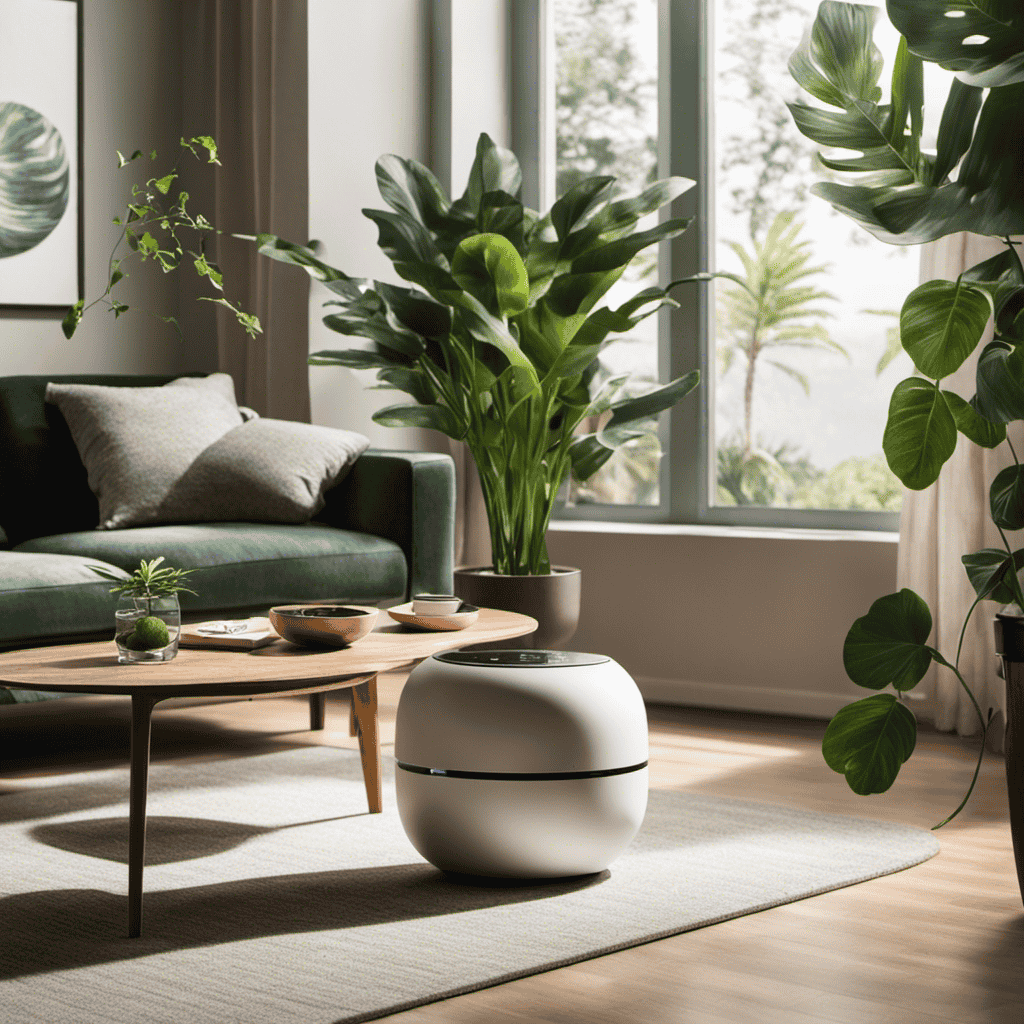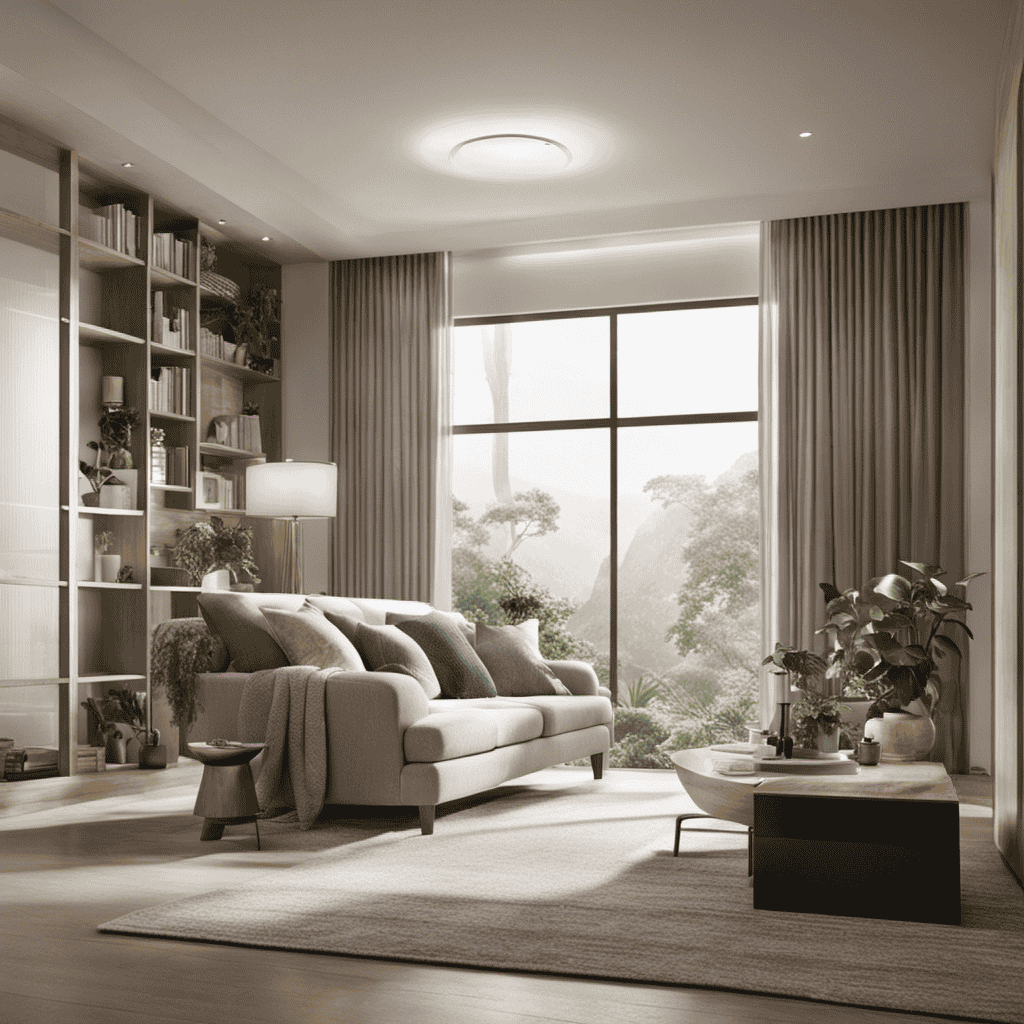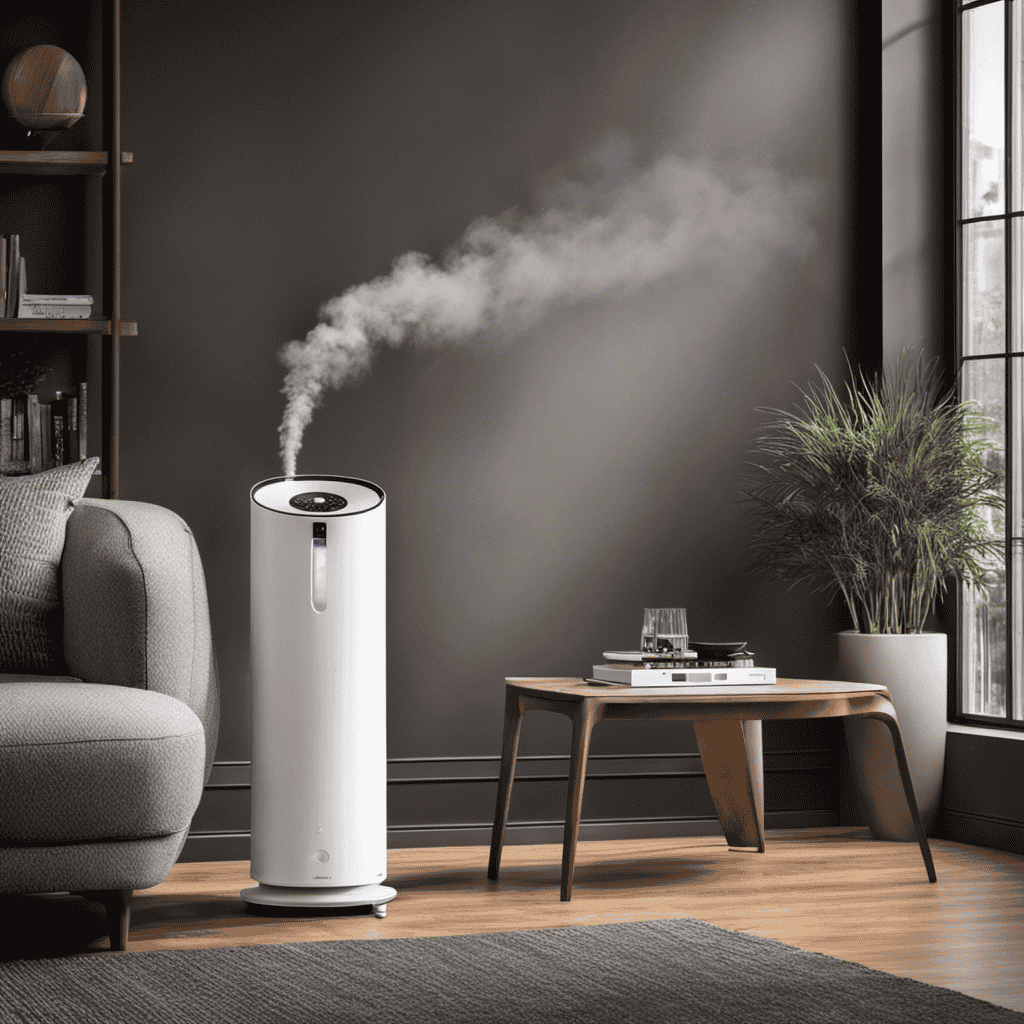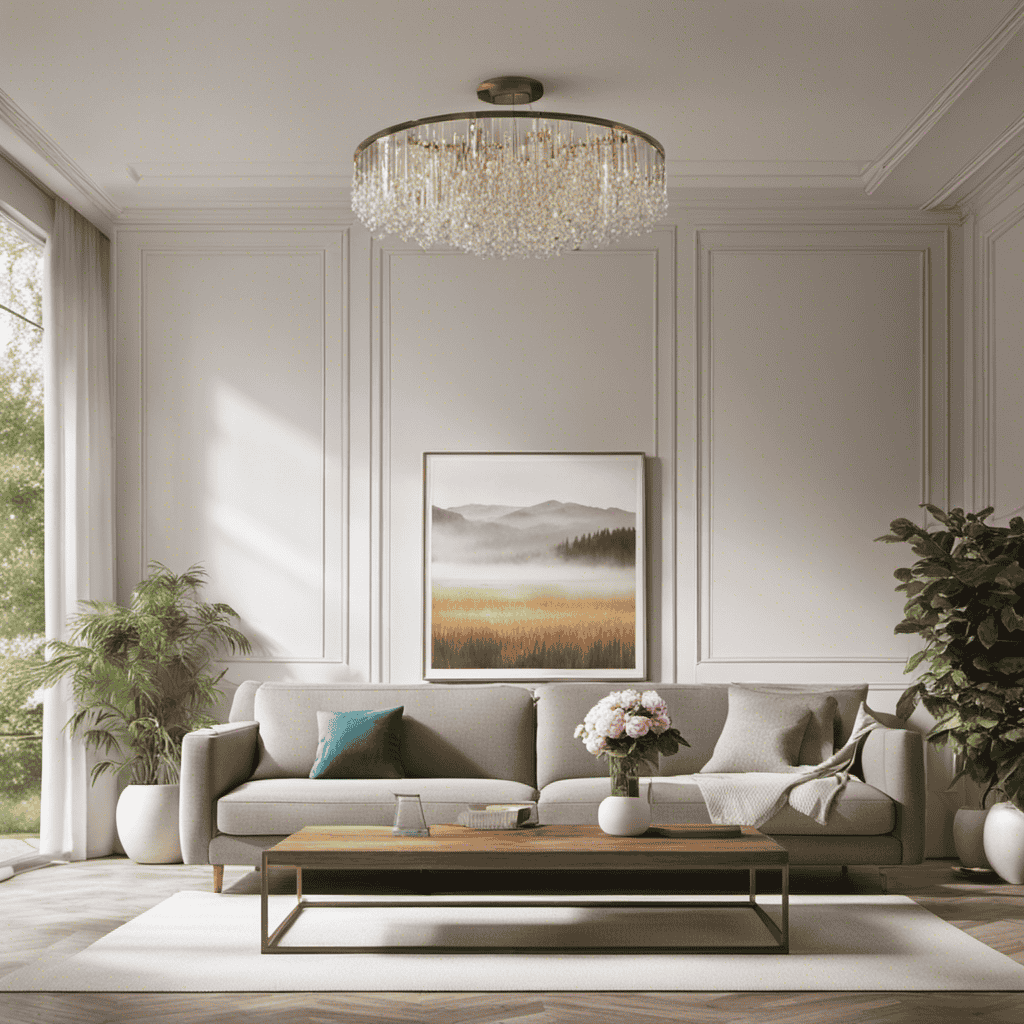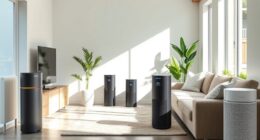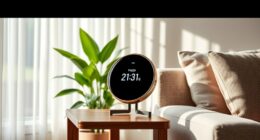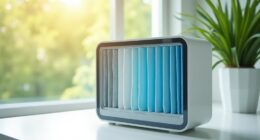Imagine easily resetting your Levoit Air Purifier with just a few easy steps. This article will walk you through resetting different functions of your air purifier, such as the filter indicator and timer function.
By following these instructions, you’ll be able to restore your air purifier to its optimal performance and enjoy clean, fresh air in no time.
So, let’s dive in and discover how to reset the Levoit Air Purifier.
Key Takeaways
- The reset button is essential for restoring the Levoit Air Purifier to default settings and resolving issues.
- Power cycling the air purifier can help resolve common issues like a frozen display or unresponsive buttons.
- Resetting the air purifier is done by pressing and holding the reset button for 5 seconds.
- Troubleshooting common issues involves checking power source, filter installation, and cleaning the fan blades or vents.
Understanding the Reset Button
To reset the Levoit air purifier, you’ll need to locate and press the reset button. The reset button is an essential feature that allows you to restore the air purifier to its default settings. It can be found on the control panel of the device, usually labeled as ‘Reset’ or represented by a small circular arrow.
Understanding the reset button is crucial for troubleshooting reset problems. If you are experiencing issues with your air purifier, such as it not turning on or not functioning properly, performing a reset can often resolve the problem. To do this, simply locate the reset button and press it for a few seconds until you see the indicator lights blink or the display screen turns off and back on. This action will reset the device, clearing any temporary glitches or errors that may have occurred.
If you encounter difficulties during the reset process, make sure to check the user manual for specific instructions. Additionally, ensure that the air purifier is properly plugged into a power source and that the circuit breaker hasn’t tripped.
Power Cycling the Air Purifier
When it comes to resetting the air purifier, power cycling is an essential process.
Power cycling involves turning off the air purifier, unplugging it from the power source, waiting for a few minutes, and then plugging it back in and turning it on again.
This process can help resolve common issues such as a frozen display, unresponsive buttons, or a malfunctioning fan.
Resetting the Air Purifier
You can easily reset the Levoit air purifier by pressing and holding the reset button for 5 seconds. This will reset the air purifier to its default settings and clear any errors or issues that may have occurred.
It is important to note that resetting the air purifier will not affect the power source or require any additional maintenance. However, regular air purifier maintenance is still necessary to ensure optimal performance. This includes cleaning or replacing the filters as recommended by the manufacturer.
By properly maintaining your air purifier, you can ensure that it continues to effectively clean the air in your home.
Now that you know how to reset the air purifier, let’s move on to the power cycling process.
Power Cycling Process
If you encounter any issues with the power cycling process, try unplugging the device and waiting for a few minutes before plugging it back in. Power cycling, also known as rebooting, is a simple yet effective troubleshooting technique that can resolve various issues with electronic devices.
Here are the benefits of power cycling and how to troubleshoot power cycling issues:
-
Benefits of Power Cycling:
- Clears temporary memory and resets software glitches.
- Improves device performance by refreshing system resources.
- Resolves connectivity issues with Wi-Fi or Bluetooth.
-
Troubleshooting Power Cycling Issues:
- Ensure the device is properly plugged into a power source.
- Check for any loose connections or damaged cables.
- If the issue persists, try power cycling the device multiple times or consult the manufacturer’s troubleshooting guide.
Troubleshooting Common Issues
To troubleshoot common issues with your air purifier, start by checking if the device is properly plugged into a power source. If it is, the next step is to troubleshoot filter replacement.
First, make sure that the filter is correctly installed and that there are no obstructions or debris blocking it. If the filter is damaged or dirty, it may need to be replaced. Refer to the manufacturer’s instructions for the proper filter replacement process.
Another common issue is fan speed problems. If the fan is not working at the desired speed, check if there are any blockages or dust accumulation in the fan blades or vents. Clean them if necessary. If the issue persists, there may be a problem with the fan motor, and it may need to be repaired or replaced.
Resetting the Filter Indicator
When resetting the filter indicator on the Levoit air purifier, simply press and hold the filter button for 5 seconds. This action will reset the filter timer and allow you to keep track of when it’s time to replace the filter.
However, there may be instances where you encounter issues when trying to reset the filter indicator. Here are some troubleshooting tips to help you resolve those problems:
-
Ensure the air purifier is powered on: Before attempting to reset the filter indicator, make sure the air purifier is turned on and connected to a power source. If the device is not powered, the reset function may not work properly.
-
Check the filter installation: If the filter is not installed correctly, the filter indicator may not reset. Double-check that the filter is securely in place and properly aligned with the unit.
-
Contact customer support: If you’ve followed the steps above and are still experiencing issues with resetting the filter indicator, it’s recommended to reach out to Levoit customer support for further assistance. They will be able to provide you with additional troubleshooting steps or arrange for a replacement if necessary.
Performing a Factory Reset
Make sure you are aware of the potential consequences before proceeding with a factory reset on your device. Performing a hard reset will erase all the data and settings on your device, restoring it to its original factory settings. This means that any personalized settings, apps, and data will be permanently deleted. It is important to back up any important data before performing a factory reset.
To help you understand the process better, here is a table outlining the steps to perform a factory reset on your device:
| Steps | Description |
|---|---|
| Step 1 | Go to the Settings menu on your device |
| Step 2 | Scroll down and tap on the ‘System’ or ‘General Management’ option, depending on your device |
| Step 3 | Look for the ‘Reset’ or ‘Backup and Reset’ option and tap on it |
| Step 4 | Tap on ‘Factory Data Reset’ or ‘Reset All Settings’ |
| Step 5 | Confirm the action by tapping on ‘Reset’ or ‘Erase All Content and Settings’ |
Resetting the Timer Function
If you want to adjust the timer function on your device, simply navigate to the settings menu. Here’s how you can do it:
-
Press the power button on your Levoit air purifier to turn it on. Make sure the device is connected to a power source.
-
Locate the control panel on the top of the air purifier. You will find a button labeled ‘Settings’. Press this button to access the settings menu.
-
Once you are in the settings menu, use the arrow buttons to navigate to the timer function. It is usually represented by a clock symbol. Press the enter button to select the timer function.
-
You can now adjust the timer settings according to your preferences. Use the arrow buttons to change the timer duration. Press the enter button to confirm your selection.
-
If you want to reset the timer function to its default settings, navigate to the option that says ‘Restore Defaults’ or ‘Reset Timer’. Press the enter button to reset the timer function.
Clearing Error Codes
To clear any error codes on your device, simply follow these steps.
Clearing error messages is an essential part of resolving technical issues with your Levoit air purifier. When an error code appears on the display, it indicates that there is a problem that needs attention.
The first step is to identify the specific error code that is being displayed. Each error code corresponds to a specific issue, such as a filter replacement reminder or a malfunctioning sensor.
Once you have identified the error code, refer to the user manual for instructions on how to clear it. In most cases, clearing the error code involves simply resetting the device. This can be done by unplugging the air purifier from the power source, waiting for a few minutes, and then plugging it back in.
After resetting, the error code should disappear, and your device should be back to normal operation. If the error code persists, it is recommended to contact Levoit customer support for further assistance in resolving the issue.
Resetting the Child Lock
When it comes to the child lock feature on your device, it’s important to understand how to activate and deactivate it properly.
In this discussion, we will explore the process of child lock activation, as well as how to reset it without the need for additional instructions.
Additionally, we will address common issues that may arise with the child lock feature and provide troubleshooting tips to help you resolve any potential problems.
Child Lock Activation
To deactivate the child lock on your Levoit air purifier, simply press and hold the Lock button for three seconds. This will unlock the control panel and allow you to make adjustments to the settings.
However, if you are experiencing any issues with the child lock, here are some troubleshooting tips to help you resolve the problem:
-
Check the Lock button: Make sure that the Lock button is not stuck or damaged. If it is, you may need to replace it to properly deactivate the child lock.
-
Power cycle the air purifier: Unplug the air purifier from the power source and wait for a few minutes. Then, plug it back in and try deactivating the child lock again.
-
Contact customer support: If none of the above solutions work, it is best to reach out to Levoit customer support for further assistance. They can provide you with specific troubleshooting steps or guide you through the process of resetting the child lock.
Resetting Without Instructions
If you’re unsure about how to reset the child lock on your specific model, try reaching out to customer support for assistance.
However, if you want to try resetting the child lock without instructions, you can do so using the remote or the app.
To reset the child lock using the remote, simply press and hold the lock button for a few seconds until the lock icon disappears from the display.
If you prefer using the app, open the app on your smartphone and navigate to the settings menu. Look for the child lock option and toggle it off to disable the lock.
Remember to consult the user manual or contact customer support if you encounter any issues during the process.
Common Issues and Troubleshooting
One common issue users may experience is a flashing display on the purifier. This can be an indication of a problem with the air filters or a need for maintenance.
To resolve this issue and ensure optimal performance of your Levoit air purifier, follow these maintenance tips:
-
Clean the air filters regularly: Remove the filters from the purifier and gently vacuum or wash them to remove dust and debris. Allow them to dry completely before reinstalling.
-
Check for filter replacement: If the filters are worn out or damaged, it is important to replace them with new ones. Refer to the user manual for specific instructions on how to do this.
-
Keep the purifier in a clean environment: Avoid placing the purifier in dusty or dirty areas, as this can clog the filters and affect its efficiency.
By following these maintenance tips for air purifiers and cleaning the filters regularly, you can prevent issues like a flashing display and ensure that your purifier functions optimally.
Now, let’s move on to troubleshooting common reset issues.
Troubleshooting Common Reset Issues
First, make sure you’ve unplugged the Levoit air purifier from the power source. Troubleshooting common reset issues with the Levoit air purifier can be frustrating, but with the right steps, you can get your device back up and running smoothly. Two common issues that require a reset are power issues and air quality readings. To help you troubleshoot these issues, I’ve created a table below with solutions and steps to follow:
| Issue | Solution |
|---|---|
| Power issues | 1. Check the power outlet and ensure it is working properly. |
| 2. Plug the air purifier into a different outlet to eliminate any issues with the current one. | |
| 3. Make sure the power cord is securely connected to the air purifier and the outlet. | |
| Air quality readings | 1. Clean the air filter and ensure it is properly inserted. |
| 2. Reset the air quality monitor by pressing and holding the ‘Reset’ button for 5 seconds. | |
| 3. Ensure that the air purifier is placed in an area with good air circulation and away from any obstructions. |
Following these troubleshooting steps should help resolve common reset issues with the Levoit air purifier. If the problem persists, it may be necessary to contact Levoit customer support for further assistance.
Frequently Asked Questions
How Often Should I Reset the Levoit Air Purifier?
Resetting the Levoit Air Purifier is an important maintenance task. It ensures that the purifier functions optimally and provides clean air.
To reset the purifier, you need to follow a few simple steps. These steps may vary depending on the specific model you have, so it’s essential to consult the user manual for precise instructions.
Regularly resetting the air purifier, according to the manufacturer’s recommendations, will help maintain its performance and prolong its lifespan.
Can I Reset the Levoit Air Purifier Remotely Using a Mobile App?
Resetting the Levoit Air Purifier remotely using a mobile app is a convenient and efficient way to control your air purifier. By utilizing the mobile app, you can easily reset the air purifier from anywhere in your home.
This feature allows you to adjust settings, monitor air quality, and schedule purification cycles with just a few taps on your smartphone. The benefits of mobile app control make it a valuable addition to your air purifier experience.
Will Resetting the Air Purifier Erase All of My Personalized Settings?
Resetting the air purifier will indeed erase all of your personalized settings. When you perform a factory reset, it restores the air purifier to its original settings, as if it were brand new. This means that any customizations or adjustments you have made will be lost.
However, it can be useful to reset the air purifier if you want to start fresh or troubleshoot any issues you may be experiencing.
What Should I Do if the Reset Button on My Levoit Air Purifier Is Not Responding?
If the reset button on my Levoit Air Purifier is not responding, there are a few troubleshooting steps I can try.
First, I should ensure that the power is properly connected and that the unit is turned on.
Next, I can try pressing and holding the reset button for a longer duration, as sometimes it requires a longer press to activate.
If these steps don’t work, I may need to contact customer support for further assistance.
How Long Does It Take for the Air Purifier to Reset After Performing a Factory Reset?
After performing a factory reset on the Levoit Air Purifier, it may take a few minutes for the device to fully reset and return to its default settings.
To troubleshoot any issues after the reset, ensure that the power is connected properly, the air filters are clean, and the device is placed in an open area for optimal air circulation.
Regularly cleaning and replacing the filters will help maintain the optimal performance of the air purifier.
Is the Reset Process for Levoit Air Purifier Similar to Partu Air Purifier?
Yes, the reset process for Levoit air purifier is similar to Partu air purifier. To reset Partu air purifier, simply press and hold the “lock” button for 3 seconds until the indicator light flashes. This will reset the device and clear any previous settings.
Conclusion
In conclusion, resetting the Levoit air purifier is a straightforward process. It can be done by following a few simple steps. Whether you need to power cycle the device, reset the filter indicator, perform a factory reset, or clear error codes, this article has provided you with all the necessary information.
Just like a skilled technician, you can easily troubleshoot any reset issues and reset the child lock. So, don’t fret if you need to reset your Levoit air purifier. With these instructions, you’ll have it up and running smoothly in no time.

